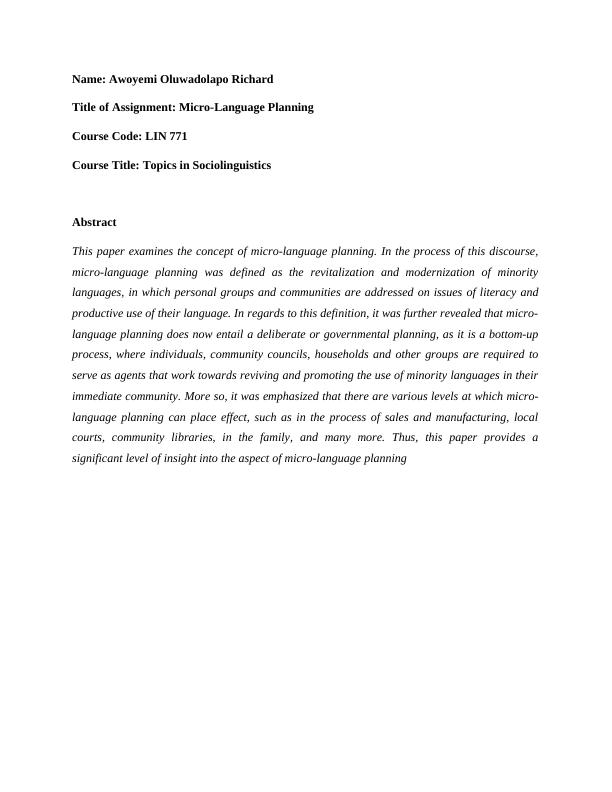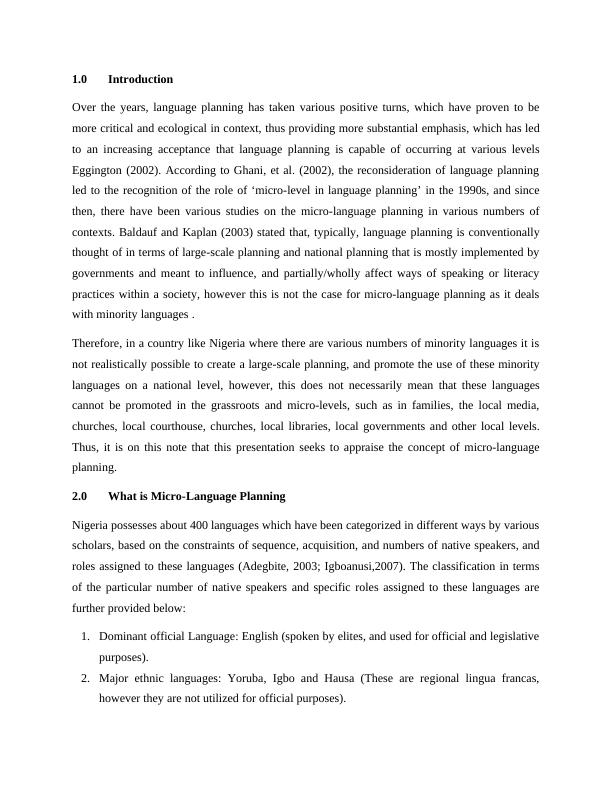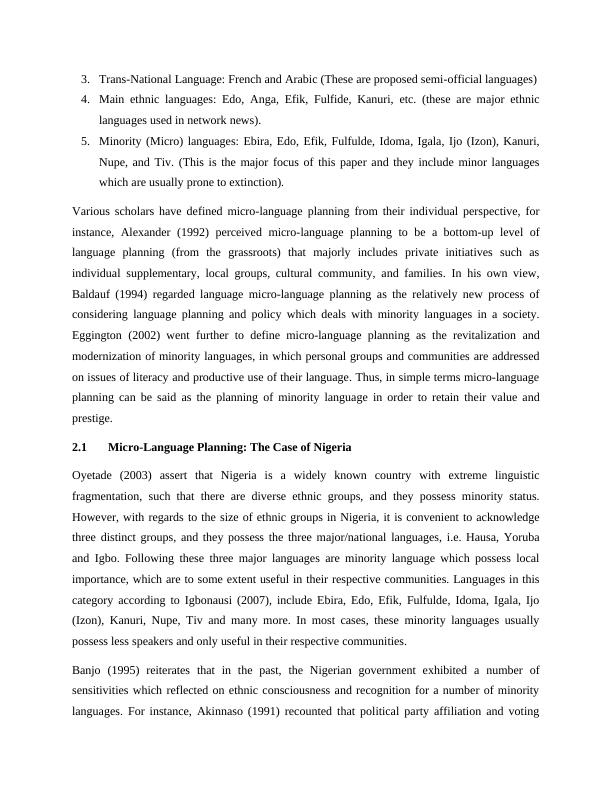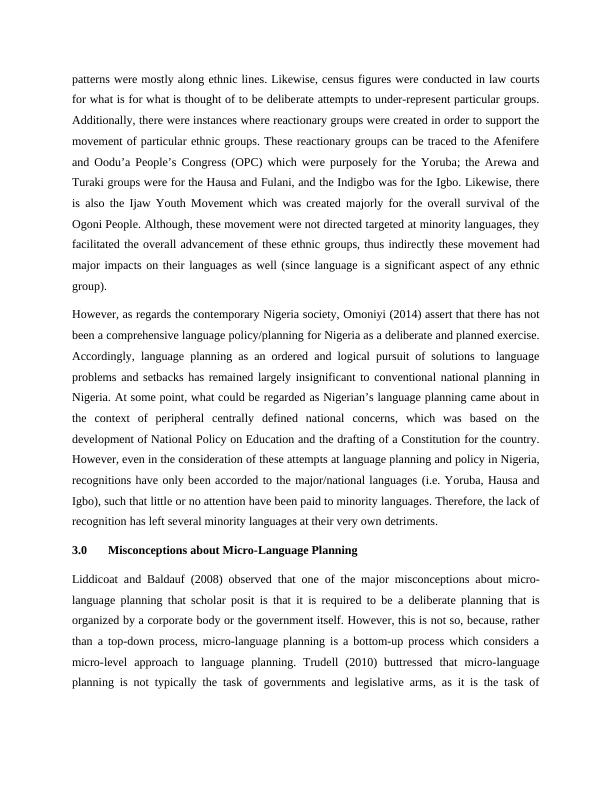Ask a question from expert
Micro-Language Planning PDF
11 Pages3506 Words90 Views
Added on 2021-10-13
Micro-Language Planning PDF
Added on 2021-10-13
BookmarkShareRelated Documents
Name: Awoyemi Oluwadolapo Richard
Title of Assignment: Micro-Language Planning
Course Code: LIN 771
Course Title: Topics in Sociolinguistics
Abstract
This paper examines the concept of micro-language planning. In the process of this discourse,
micro-language planning was defined as the revitalization and modernization of minority
languages, in which personal groups and communities are addressed on issues of literacy and
productive use of their language. In regards to this definition, it was further revealed that micro-
language planning does now entail a deliberate or governmental planning, as it is a bottom-up
process, where individuals, community councils, households and other groups are required to
serve as agents that work towards reviving and promoting the use of minority languages in their
immediate community. More so, it was emphasized that there are various levels at which micro-
language planning can place effect, such as in the process of sales and manufacturing, local
courts, community libraries, in the family, and many more. Thus, this paper provides a
significant level of insight into the aspect of micro-language planning
Title of Assignment: Micro-Language Planning
Course Code: LIN 771
Course Title: Topics in Sociolinguistics
Abstract
This paper examines the concept of micro-language planning. In the process of this discourse,
micro-language planning was defined as the revitalization and modernization of minority
languages, in which personal groups and communities are addressed on issues of literacy and
productive use of their language. In regards to this definition, it was further revealed that micro-
language planning does now entail a deliberate or governmental planning, as it is a bottom-up
process, where individuals, community councils, households and other groups are required to
serve as agents that work towards reviving and promoting the use of minority languages in their
immediate community. More so, it was emphasized that there are various levels at which micro-
language planning can place effect, such as in the process of sales and manufacturing, local
courts, community libraries, in the family, and many more. Thus, this paper provides a
significant level of insight into the aspect of micro-language planning

1.0 Introduction
Over the years, language planning has taken various positive turns, which have proven to be
more critical and ecological in context, thus providing more substantial emphasis, which has led
to an increasing acceptance that language planning is capable of occurring at various levels
Eggington (2002). According to Ghani, et al. (2002), the reconsideration of language planning
led to the recognition of the role of ‘micro-level in language planning’ in the 1990s, and since
then, there have been various studies on the micro-language planning in various numbers of
contexts. Baldauf and Kaplan (2003) stated that, typically, language planning is conventionally
thought of in terms of large-scale planning and national planning that is mostly implemented by
governments and meant to influence, and partially/wholly affect ways of speaking or literacy
practices within a society, however this is not the case for micro-language planning as it deals
with minority languages .
Therefore, in a country like Nigeria where there are various numbers of minority languages it is
not realistically possible to create a large-scale planning, and promote the use of these minority
languages on a national level, however, this does not necessarily mean that these languages
cannot be promoted in the grassroots and micro-levels, such as in families, the local media,
churches, local courthouse, churches, local libraries, local governments and other local levels.
Thus, it is on this note that this presentation seeks to appraise the concept of micro-language
planning.
2.0 What is Micro-Language Planning
Nigeria possesses about 400 languages which have been categorized in different ways by various
scholars, based on the constraints of sequence, acquisition, and numbers of native speakers, and
roles assigned to these languages (Adegbite, 2003; Igboanusi,2007). The classification in terms
of the particular number of native speakers and specific roles assigned to these languages are
further provided below:
1.Dominant official Language: English (spoken by elites, and used for official and legislative
purposes).
2.Major ethnic languages: Yoruba, Igbo and Hausa (These are regional lingua francas,
however they are not utilized for official purposes).
Over the years, language planning has taken various positive turns, which have proven to be
more critical and ecological in context, thus providing more substantial emphasis, which has led
to an increasing acceptance that language planning is capable of occurring at various levels
Eggington (2002). According to Ghani, et al. (2002), the reconsideration of language planning
led to the recognition of the role of ‘micro-level in language planning’ in the 1990s, and since
then, there have been various studies on the micro-language planning in various numbers of
contexts. Baldauf and Kaplan (2003) stated that, typically, language planning is conventionally
thought of in terms of large-scale planning and national planning that is mostly implemented by
governments and meant to influence, and partially/wholly affect ways of speaking or literacy
practices within a society, however this is not the case for micro-language planning as it deals
with minority languages .
Therefore, in a country like Nigeria where there are various numbers of minority languages it is
not realistically possible to create a large-scale planning, and promote the use of these minority
languages on a national level, however, this does not necessarily mean that these languages
cannot be promoted in the grassroots and micro-levels, such as in families, the local media,
churches, local courthouse, churches, local libraries, local governments and other local levels.
Thus, it is on this note that this presentation seeks to appraise the concept of micro-language
planning.
2.0 What is Micro-Language Planning
Nigeria possesses about 400 languages which have been categorized in different ways by various
scholars, based on the constraints of sequence, acquisition, and numbers of native speakers, and
roles assigned to these languages (Adegbite, 2003; Igboanusi,2007). The classification in terms
of the particular number of native speakers and specific roles assigned to these languages are
further provided below:
1.Dominant official Language: English (spoken by elites, and used for official and legislative
purposes).
2.Major ethnic languages: Yoruba, Igbo and Hausa (These are regional lingua francas,
however they are not utilized for official purposes).

3.Trans-National Language: French and Arabic (These are proposed semi-official languages)
4.Main ethnic languages: Edo, Anga, Efik, Fulfide, Kanuri, etc. (these are major ethnic
languages used in network news).
5.Minority (Micro) languages: Ebira, Edo, Efik, Fulfulde, Idoma, Igala, Ijo (Izon), Kanuri,
Nupe, and Tiv. (This is the major focus of this paper and they include minor languages
which are usually prone to extinction).
Various scholars have defined micro-language planning from their individual perspective, for
instance, Alexander (1992) perceived micro-language planning to be a bottom-up level of
language planning (from the grassroots) that majorly includes private initiatives such as
individual supplementary, local groups, cultural community, and families. In his own view,
Baldauf (1994) regarded language micro-language planning as the relatively new process of
considering language planning and policy which deals with minority languages in a society.
Eggington (2002) went further to define micro-language planning as the revitalization and
modernization of minority languages, in which personal groups and communities are addressed
on issues of literacy and productive use of their language. Thus, in simple terms micro-language
planning can be said as the planning of minority language in order to retain their value and
prestige.
2.1 Micro-Language Planning: The Case of Nigeria
Oyetade (2003) assert that Nigeria is a widely known country with extreme linguistic
fragmentation, such that there are diverse ethnic groups, and they possess minority status.
However, with regards to the size of ethnic groups in Nigeria, it is convenient to acknowledge
three distinct groups, and they possess the three major/national languages, i.e. Hausa, Yoruba
and Igbo. Following these three major languages are minority language which possess local
importance, which are to some extent useful in their respective communities. Languages in this
category according to Igbonausi (2007), include Ebira, Edo, Efik, Fulfulde, Idoma, Igala, Ijo
(Izon), Kanuri, Nupe, Tiv and many more. In most cases, these minority languages usually
possess less speakers and only useful in their respective communities.
Banjo (1995) reiterates that in the past, the Nigerian government exhibited a number of
sensitivities which reflected on ethnic consciousness and recognition for a number of minority
languages. For instance, Akinnaso (1991) recounted that political party affiliation and voting
4.Main ethnic languages: Edo, Anga, Efik, Fulfide, Kanuri, etc. (these are major ethnic
languages used in network news).
5.Minority (Micro) languages: Ebira, Edo, Efik, Fulfulde, Idoma, Igala, Ijo (Izon), Kanuri,
Nupe, and Tiv. (This is the major focus of this paper and they include minor languages
which are usually prone to extinction).
Various scholars have defined micro-language planning from their individual perspective, for
instance, Alexander (1992) perceived micro-language planning to be a bottom-up level of
language planning (from the grassroots) that majorly includes private initiatives such as
individual supplementary, local groups, cultural community, and families. In his own view,
Baldauf (1994) regarded language micro-language planning as the relatively new process of
considering language planning and policy which deals with minority languages in a society.
Eggington (2002) went further to define micro-language planning as the revitalization and
modernization of minority languages, in which personal groups and communities are addressed
on issues of literacy and productive use of their language. Thus, in simple terms micro-language
planning can be said as the planning of minority language in order to retain their value and
prestige.
2.1 Micro-Language Planning: The Case of Nigeria
Oyetade (2003) assert that Nigeria is a widely known country with extreme linguistic
fragmentation, such that there are diverse ethnic groups, and they possess minority status.
However, with regards to the size of ethnic groups in Nigeria, it is convenient to acknowledge
three distinct groups, and they possess the three major/national languages, i.e. Hausa, Yoruba
and Igbo. Following these three major languages are minority language which possess local
importance, which are to some extent useful in their respective communities. Languages in this
category according to Igbonausi (2007), include Ebira, Edo, Efik, Fulfulde, Idoma, Igala, Ijo
(Izon), Kanuri, Nupe, Tiv and many more. In most cases, these minority languages usually
possess less speakers and only useful in their respective communities.
Banjo (1995) reiterates that in the past, the Nigerian government exhibited a number of
sensitivities which reflected on ethnic consciousness and recognition for a number of minority
languages. For instance, Akinnaso (1991) recounted that political party affiliation and voting

patterns were mostly along ethnic lines. Likewise, census figures were conducted in law courts
for what is for what is thought of to be deliberate attempts to under-represent particular groups.
Additionally, there were instances where reactionary groups were created in order to support the
movement of particular ethnic groups. These reactionary groups can be traced to the Afenifere
and Oodu’a People’s Congress (OPC) which were purposely for the Yoruba; the Arewa and
Turaki groups were for the Hausa and Fulani, and the Indigbo was for the Igbo. Likewise, there
is also the Ijaw Youth Movement which was created majorly for the overall survival of the
Ogoni People. Although, these movement were not directed targeted at minority languages, they
facilitated the overall advancement of these ethnic groups, thus indirectly these movement had
major impacts on their languages as well (since language is a significant aspect of any ethnic
group).
However, as regards the contemporary Nigeria society, Omoniyi (2014) assert that there has not
been a comprehensive language policy/planning for Nigeria as a deliberate and planned exercise.
Accordingly, language planning as an ordered and logical pursuit of solutions to language
problems and setbacks has remained largely insignificant to conventional national planning in
Nigeria. At some point, what could be regarded as Nigerian’s language planning came about in
the context of peripheral centrally defined national concerns, which was based on the
development of National Policy on Education and the drafting of a Constitution for the country.
However, even in the consideration of these attempts at language planning and policy in Nigeria,
recognitions have only been accorded to the major/national languages (i.e. Yoruba, Hausa and
Igbo), such that little or no attention have been paid to minority languages. Therefore, the lack of
recognition has left several minority languages at their very own detriments.
3.0 Misconceptions about Micro-Language Planning
Liddicoat and Baldauf (2008) observed that one of the major misconceptions about micro-
language planning that scholar posit is that it is required to be a deliberate planning that is
organized by a corporate body or the government itself. However, this is not so, because, rather
than a top-down process, micro-language planning is a bottom-up process which considers a
micro-level approach to language planning. Trudell (2010) buttressed that micro-language
planning is not typically the task of governments and legislative arms, as it is the task of
for what is for what is thought of to be deliberate attempts to under-represent particular groups.
Additionally, there were instances where reactionary groups were created in order to support the
movement of particular ethnic groups. These reactionary groups can be traced to the Afenifere
and Oodu’a People’s Congress (OPC) which were purposely for the Yoruba; the Arewa and
Turaki groups were for the Hausa and Fulani, and the Indigbo was for the Igbo. Likewise, there
is also the Ijaw Youth Movement which was created majorly for the overall survival of the
Ogoni People. Although, these movement were not directed targeted at minority languages, they
facilitated the overall advancement of these ethnic groups, thus indirectly these movement had
major impacts on their languages as well (since language is a significant aspect of any ethnic
group).
However, as regards the contemporary Nigeria society, Omoniyi (2014) assert that there has not
been a comprehensive language policy/planning for Nigeria as a deliberate and planned exercise.
Accordingly, language planning as an ordered and logical pursuit of solutions to language
problems and setbacks has remained largely insignificant to conventional national planning in
Nigeria. At some point, what could be regarded as Nigerian’s language planning came about in
the context of peripheral centrally defined national concerns, which was based on the
development of National Policy on Education and the drafting of a Constitution for the country.
However, even in the consideration of these attempts at language planning and policy in Nigeria,
recognitions have only been accorded to the major/national languages (i.e. Yoruba, Hausa and
Igbo), such that little or no attention have been paid to minority languages. Therefore, the lack of
recognition has left several minority languages at their very own detriments.
3.0 Misconceptions about Micro-Language Planning
Liddicoat and Baldauf (2008) observed that one of the major misconceptions about micro-
language planning that scholar posit is that it is required to be a deliberate planning that is
organized by a corporate body or the government itself. However, this is not so, because, rather
than a top-down process, micro-language planning is a bottom-up process which considers a
micro-level approach to language planning. Trudell (2010) buttressed that micro-language
planning is not typically the task of governments and legislative arms, as it is the task of

End of preview
Want to access all the pages? Upload your documents or become a member.
Related Documents
1431 - English for Adults : Assignmentlg...
|11
|2005
|59
Ethical Dilemma in Health and Social Care : Assignmentlg...
|12
|3086
|484